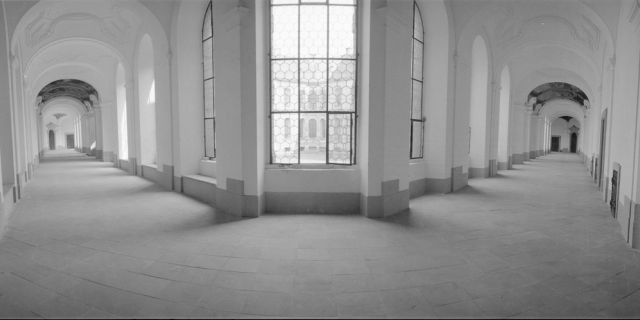
Oxymoron
Bram (Joost Verhey)
Man looks at Woman, Woman looks at Man |(Nathalie Alonso Casale and Pavel Semčenko)
11 May 2017, 8 PM at Cinema Ponrepo
Join us 11 May 2017, 8 PM at the Bio Ponrepo for a screening of Bram (16mm, DVD, 68 mins.) Scenario and Direction: Joost Verhey (1993). In 1987, as a result of thirty years of suffering from diabetes, the visual artist Bram Cox (1934-1998) lost her eyesight. By turning herself into a sound artist she succeeded in changing her mode of work. In addition, we will also screen: Man looks at Woman, Woman looks at Man (35mm, b&w and color, 18 mins.) Direction, scenario, casting, editing: Nathalie Alonso Casale and Pavel Semčenko (1999). Both films were created during symposia at Plasy monastery from 1992-1999.
ʀᴇᴀᴅ ᴀʀᴛɪᴄʟᴇ …
čᴇsᴋʏ …

An Interview with Sarah Washington
vs. Interpretation 2016
Our series of video interviews continues with this, our fifth, with Sarah Washington, who did an improvised performance at the former Prague Electric Company with Knut Aufermann as the duo Tonic Train. In the upcoming months we will be offering a continuation of this series, featuring these artists, who also appeared at the 2016 vs. Interpretation festival: Praed, Lê Quan Ninh, and Christine Abdelnour.
ʀᴇᴀᴅ ᴀʀᴛɪᴄʟᴇ …
čᴇsᴋʏ …

A Gallery for the Taking
The Stolen Gallery
Ukradená Galerie
Artur Magrot and Alessandra (Alex) Svátek founded Ukradená Galerie (“The Stolen Gallery”) in 2010 in Český Krumlov, a town well known not only for its picturesque qualities. Perhaps because it is full of students and often visited by international artists, Český Krumlov is hungry for alternative culture, something Magrot and Svátek readily discovered when the idea for Ukradená Galerie came to them. Ukradená Galerie comes out of a tradition of street art while playing with elements of the art establishment. “The gallery’s stolen,” says Artur. “But the question is not only who stole it but also whether it was stolen from you or for you?”
ʀᴇᴀᴅ ᴀʀᴛɪᴄʟᴇ …

Excavating the Future
An Archaeology and Future of Moving Pictures: A Case Study in (Un)Archiving Unstable Media
The latest collection to be added to our mediateka consists of a nearly-lost but less-than-perfectly-recovered copy of a website from the early days of the internet posted on the occasion of the symposium “Excavating the Future,” held at Goethe Institut Prag in 2001. The history of “new media” and “electronic art” in Czechoslovak and Czech culture is rather new, but quickly aging, and seldom seen in a broader, international context. Among the most prominent personalities in the field are is Vilém Flusser. His name (and the names of others) is linked with establishing two cultural-artistic events founded in the early 90s: the “Hi-Tech/Art” festival/exhibitions in Brno (1994-97) and a series of annual international, interdisciplinary “Flusser Media Conferences,” which were organized between 1992 and 1997 by Andreas Ströhl, and in 2001 and 2007 by others. Ströhl and Flusser met in Prague in November 1991.
ʀᴇᴀᴅ ᴀʀᴛɪᴄʟᴇ …
čᴇsᴋʏ …
An Open Discussion on Flusserian Questions
Thursday 4 May at 6:30 PM
GAMU, Malostranské náměstí 12, Praha 1
Discussion on the theme of the exhibition BEZEDNO: Vilém Flusser and Art
Milena Slavická Ph.D., Mgr. Kamil Nábělek, and Mgr. Miloš Vojtěchovský
Vilém Flusser was one of the fundamental personalities who contributed to the introduction of New Media to the Czech scene in a contemporary international context. Flusser’s images were enthusiastically accepted here, only to gradually become “domesticated” and reduced to a few themes about codes, technical images, electronic media and digital photography. In 2017, is there still something to be discovered in Flusser’s texts that can be built upon, or are they mainly the subject of academic and archival research?
gamu.cz/cs/flusser
Otevřená diskuze k flusserovským otázkám
čtvrtek 4. května 18.30
GAMU, Malostranské náměstí 12, Praha 1
diskuze k tématu výstavy BEZEDNO. Vilém Flusser a umění
PhDr. Milena Slavická, Mgr. Kamil Nábělek, Mgr. Miloš Vojtěchovský
Vilém Flusser byl jednou ze zásadních osobností, které přispěly k uvedení „českého novomediálního obrazu“ do aktuálních mezinárodních souvislostí. Flusserovy obrazy byly v Čechách nadšeně přijímány, aby se postupně „domestifikovaly“ a redukovaly na několik tézí o kódech, technoobrazech, elektronických médiích a digitální fotografii. Je ve Flusserových textech v roce 2017 ještě stále co objevovat, na co navazovat, nebo jsou hlavně námětem akademického výzkumu a bádání v archivech?
gamu.cz/cs/flusser